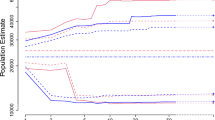Abstract
Weighted analysis methods are considered for cohort sampling designs that allow subsampling of both cases and non-cases, but with cases generally sampled more intensively. The methods fit into the general framework for the analysis of survey sampling designs considered by Lin (Biometrika 87:37–47, 2000). Details are given for applying the general methodology in this setting. In addition to considering proportional hazards regression, methods for evaluating the representativeness of the sample and for estimating event-free probabilities are given. In a small simulation study, the one-sample cumulative hazard estimator and its variance estimator were found to be nearly unbiased, but the true coverage probabilities of confidence intervals computed from these sometimes deviated significantly from the nominal levels. Methods for cross-validation and for bootstrap resampling, which take into account the dependencies in the sample, are also considered.
Similar content being viewed by others
References
Barlow WE (1994) Robust variance estimation for the case-cohort design. Biometrics 50: 1064–1072
Borgan O, Langholz B, Samuelsen SO, Goldstein L, Pagoda J (2000) Exposure stratified case-cohort designs. Lifetime Data Anal 6: 39–58
Breslow NE, Wellner JA (2007) Weighted likelihood for semiparametric models and two-phase stratified samples, with application to Cox regression. Scand J Stat 34: 88–102
Chen K, Lo S-H (1999) Case-cohort and case–control analysis with Cox’s model. Biometrika 86: 755–764
Chen K (2001) Generalized case-cohort sampling. J R Stat Soc B 63: 791–809
Dupuy A, Simon RM (2007) Critical review of published microarray studies for cancer outcome and guidelines on statistical analysis and reporting. J Natl Cancer Inst 99: 147–157
Goldstein LJ, Gray R, Badve S, Childs BH, Yoshizawa C, Rowley S, Shak S, Baehner FL, Ravdin PM, Davidson NE, Sledge GW, Perez E, Shulman LN, Martino S, Sparano JA (2008) Prognostic utility of the 21-gene assay in hormone receptor-positive operable breast cancer compared with classical clinicopathologic features. J Clin Oncol 26(25). doi:10.1200/JCO.2007.14.4501
Lin DY (2000) On fitting Cox’s proportional hazards models to survey data. Biometrika 87: 37–47
Nan B (2004) Efficient estimation for case-cohort studies. Can J Stat 32: 403–419
Overton WS, Stehman SV (1995) The Horvitz-Thompson theorem as a unifying perspective for probability sampling: with examples from natural resource sampling. Am Stat 49: 261–268
Prentice RL (1986) A case-cohort design for epidemiologic cohort studies and disease prevention trials. Biometrika 73: 1–11
Prentice RL, Breslow NE (1978) Retrospective studies and failure time models. Biometrika 65: 153–158
Rademacher MD, McShane LM, Simon R (2002) A paradigm for class prediction using gene expression profiles. J Comput Biol 9: 505–511
Rodrigues L, Kirkwood BR (1990) Case–control designs in the study of common diseases: updates on the demise of the rare disease assumption and the choice of sampling scheme for controls. Int J Epidemiol 19: 205–213
Rothman KJ, Greenland S (1998) Modern Epidemiology, 2nd edn. Lippincott Williams & Wilkins, Philadelphia
Rundle AG, Vineis P, Ahsan H (2005) Design options for molecular epidemiology research within cohort studies. Cancer Epidemiol Biomarkers Prev 14: 1899–1907
Samuelsen SO, Anestad H, Skrondal A (2007) Stratified case-cohort analysis of general cohort sampling designs. Scand J Stat 34: 103–119
Scheike TH, Martinussen T (2004) Maximum likelihood estimation for Cox’s regression model under case-cohort sampling. Scand J Stat 31: 283–293
Therneau TM, Grambsch PM (2000) Modeling survival data. Springer, New York
Author information
Authors and Affiliations
Corresponding author
Additional information
An erratum to this article can be found at http://dx.doi.org/10.1007/s10985-009-9116-6
Rights and permissions
About this article
Cite this article
Gray, R.J. Weighted analyses for cohort sampling designs. Lifetime Data Anal 15, 24–40 (2009). https://doi.org/10.1007/s10985-008-9095-z
Received:
Accepted:
Published:
Issue Date:
DOI: https://doi.org/10.1007/s10985-008-9095-z




